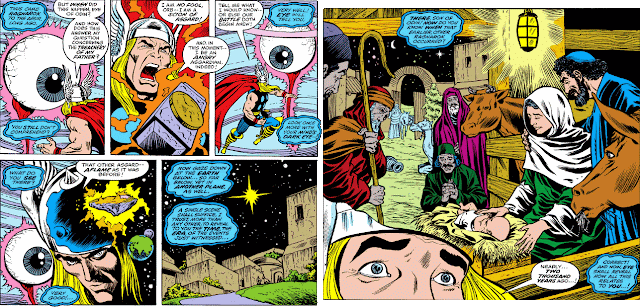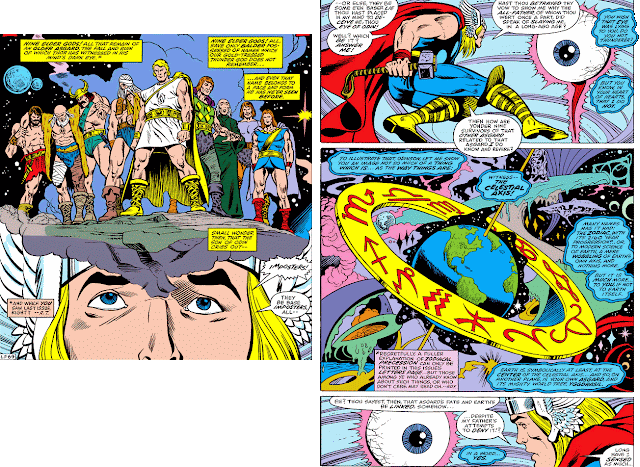In late 1976, writer Steve Englehart produced what appeared to be the definitive origin of not only Odin, Lord of Asgard, but of Asgard itself, along with its pantheon of gods. And just for good measure, the events of the tale included the creation of the Earth, as well as the first humans!
Over time, we've learned that the Asgardians have come to believe, based on these ancient legends, that Earth's fate is inextricably tied to their own; more to the point, that when Asgard finally meets its end as a result of the prophesied doom of Ragnarok, so too must Earth perish.
In the interim, however, we've been witness to some Ragnarok "false alarms," including one particular Ragnarok which Odin orchestrated into occurring in order to ensure the survival of the realm and all within; and we've also seen the true Ragnarok come and go, with no repercussions whatsoever for we poor mortals or our world. Ragnarok, however, is not ground that Englehart is interested in covering here, but he does go on to illustrate how the other gods of Asgard enter the picture--and yes, one god in particular.
The information about Bilskirnir, Thor's massive 540-chamber palace, is a peculiar piece of trivia Englehart injects which can't help but stand out in this segment. We know that at this point in time, Thor is utterly lacking in humility, so the fact that he wants his dwelling to stand out above all others shouldn't be surprising--but one has to wonder if Thor has ever stepped foot in half the number of chambers this gargantuan residence offers. (An artist's cutaway of the place is probably too much to ask.)
Englehart's presentation here leaves room for succeeding writers to further interpret and use for their own purposes--and nearly 3½ years later, that's just what we find Roy Thomas doing, when he adapts Englehart's information for his own tale that involves Thor's pursuit of details regarding the Celestials' fifty-year judgment of Earth. It's a story where Thor would not only discover another, unknown Ragnarok which took place, but would also reveal additional circumstances regarding the origin of Odin which deviate from what we've seen.
For the answers that Thor seeks, Thomas would put him on a path which would eventually culminate in Mighty Thor #300 (though Thomas would no longer be scripting the series by that time) and provide Thor--and, heaven knows, us--with more of a saga than perhaps the story merited, by virtue of a single question which Thor considered to be a priority over all others. To gain perspective on the matter, we should backtrack to the aftermath of a conflict which took place between the Eternals and the twin forces of Asgard and Olympus, where Odin refused to slay Thor when he had him at his mercy while exclaiming that he had done just that at some point previously. When Thor presses him on the matter, Odin responds with only a cryptic riddle which paraphrases several verses of, of all things, a mortal book of Christian scriptures.
Fortunately, Thomas's false Ragnarok story of 1978 provides Thor with the clue he needs to proceed further in deciphering the riddle--though no small amount of thanks should go to a "mystic" hammer which is able to act on its master's most obtuse train of thought, leading him, finally, to the strange entity which will provide this tale's narrative from this point forward.
We can only guess why this "eye of Odin" is hostile toward the Thunder God, though no explanation is provided on why it's been viciously attacking the helpless denizens of this world unprovoked. (Apparently it was thought that Thor simply approaching and either asking or demanding the eye for the information he needed lacked the excitement which would better engage the reader.) At any rate, though clearly formidable, the eye will meet its match in Thor's persistence, and his power--and Thor becomes witness to a coming of Ragnarok that he has never seen, but which has already happened.
In this Ragnarok of the "Aesir," a term which is borrowed from Englehart's tale, Thomas instead deviates from that story at the point where the Thor we know from his inception in Journey Into Mystery is introduced, and inserts an Asgard as well as a different set of gods aligned more with our own myths and legends of those times. Here, Odin did not (or was not able to) place the dead Balder in stasis in order to prevent his taking by the Goddess of Death, Hela--and so the fierce prophecy of Ragnarok took hold of the realm, and the Aesir, along with the whole of Asgard, fell to death and ultimate destruction.
"...Balder, God of Light--returning from the hell into which he had descended after his death at Hoder's hand." How nice for Balder, who sidesteps any explanation as to how he could just come back from the dead like this, no worse for wear--there are hordes of Aesir warriors who perished during Ragnarok who would no doubt have preferred similar treatment from Thomas. As for the other survivors, how they avoided being charred to a cinder by Surtur along with the rest of Asgard is anyone's guess.
As to when this event took place, the information comes as a shock to Thor--which is understandable, since the conflagration occurred not so long ago to an immortal like himself. In fact, the date given by the eye would put it at only 1,000 years before the coming of the Third Host of the Celestials.
And the fate of Earth? Here, as in other instances, Earth weathers the disaster without so much as a tremor--while Thor discovers that Earth and Asgard are indeed linked, but not in the way the Asgardians had come to assume.
That leaves us with another part of the prophecy which is expected--a new Golden Age for Asgard, which can't be far behind considering how swiftly molten rock can morph into lush landscapes, a speed which Balder and the others take in stride. But there are other pieces which fall into place (almost literally so) that facilitate the new age of gods--not the least of which is its new, reincarnated ruler.
Nor does Odin waste any time in creating on the spot this new age of Asgard, complete with an entire population of gods and foes whose minds are carefully adjusted by this "all-Father" to align with their new lives and new home and, in short order, suppress all that came before--though Odin sees value in retaining the prior myths of creation which Englehart has detailed.
Eventually, Thor would also receive his answer from the eye as to how and when he was previously slain by Odin, a story within a story that takes us finally to issue #300 and the showdown with the Celestials. Conceivably, Odin could give the memories of Thor (who is the only Asgardian who retains the true facts of their existence) treatment similar to that which was given his kinsmen, behavior we normally wouldn't put past him. However, this part of the storyline involving the eye was rendered somewhat moot by a story by Walt Simonson which took place in 1985 that cast doubt on Thomas's version of events, as well as Simonson's own origin for Odin which details fates for Odin's brothers, Vili and Ve, that differ from what we've seen here. Consequently, it falls to the book's readers to sift through it all and determine what they prefer to view as fact--something our friend Tiwaz will one day have the wisdom to impart to Odin's son.































It's very convoluted, but I kind of like how it sets up why Marvel asgardians are different to the legendary aesir.
ReplyDeleteMind you, it'd have to go a lot further to dislodge Mr. Simonson's version as my preference. If I heard two different tales from Odin and a giant eyeball with a grudge, I know which I'd believe.
Well said, Warren! (Say, you wouldn't happen to know a thing or two about carving animated ice sculptures, would you? ;) )
ReplyDeleteTo paraphrase Buri, "never trust an eyeball with a grudge."
ReplyDeleteWow. C.F., the Norse creation story is powerfully depicted here.
Hey, I noticed in one frame up there Thor is spinning his hammer around in what I call "the atomic effect". (that's the best name I came up with)
Y'know, like those old depictions of atoms we saw when we were kids where the protons and neutrons are spinning around a nucleus.
Like you'd see on an old Devo uniform.
Kirby invented it (naturally) but I first saw it when I was a little M.P. when Thor was fixing to put some hurt down on Ego, courtesy of Rich Buckler.
Even as a little kid I knew what that image meant. I figured Thor must have atomic powers. He's a walking atomic bomb! Hey, it was the Cold War, man.
That image gets me every time! If I was a Thor artist I'd swipe it too.
M.P.
So Jesus exists in the Marvel Universe but why does he never make an appearance?
ReplyDeleteI always liked Walt Simonson's retcon of this story, which had a character simply ask Thor "why would you believe a giant floating eyeball?" or words to that effect.
ReplyDelete